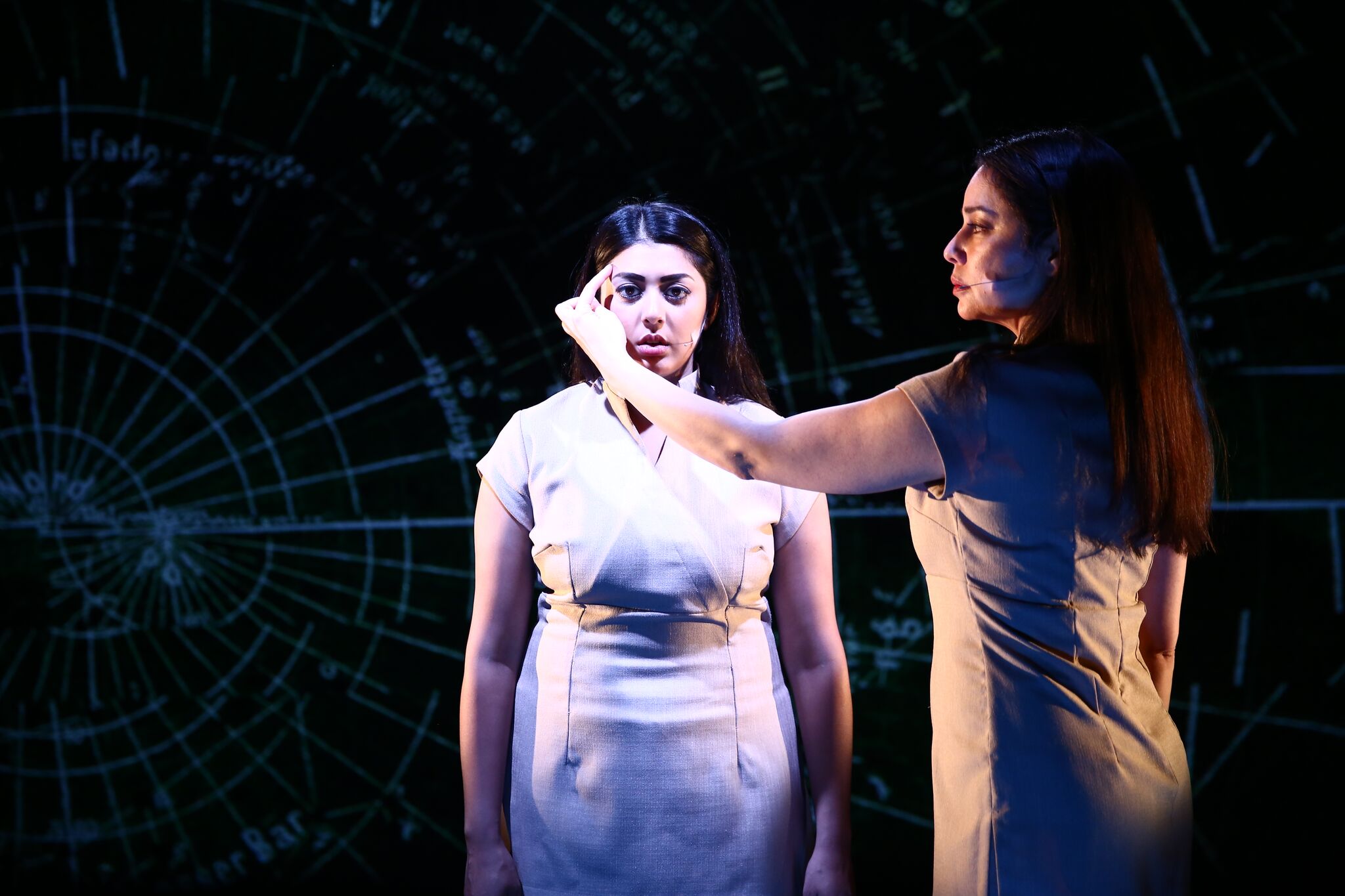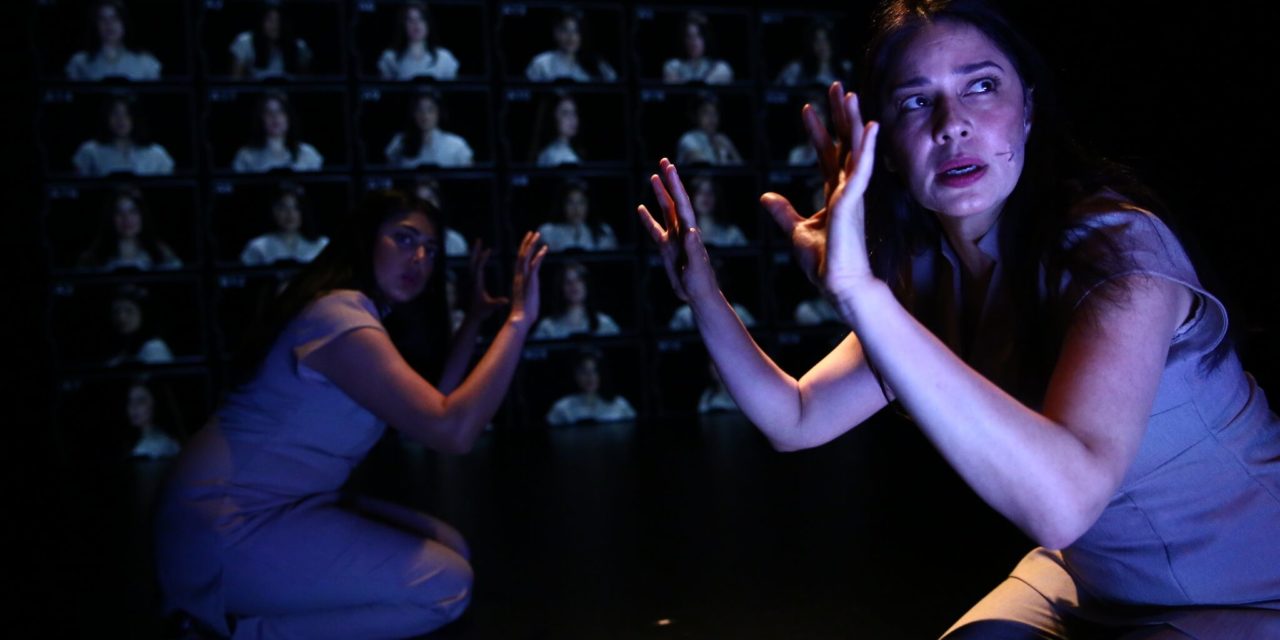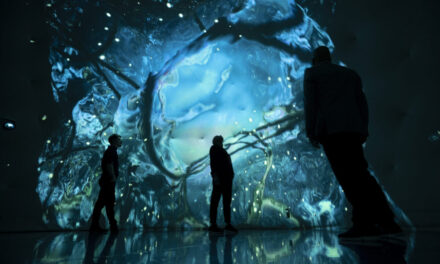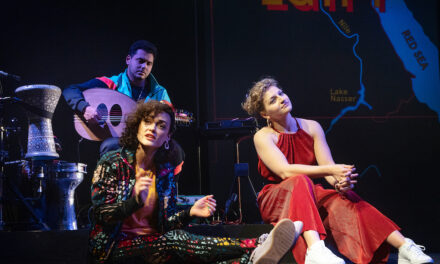There is a rather iconic scene in The Devil Wears Prada where Miranda (played by Meryl Streep) recounts the lineage of the cerulean sweater that Andi (played by Anne Hathaway) is wearing. Beyond its being a fairly brutal dressing-down, it also outlines how avant-garde fashion influences commercial tastes. Miranda makes it clear that although Andi may feign indifference to, and not understand, avant-garde fashion, its existence is absolute, and her apathy is of no consequence to its absolute impact.
Five years from now there will be a sci-fi/ethno-futuristic production that explodes onto the commercial Broadway scene. It will bring audiences to its knees in admiration of its insight, perspective, and originality. It will be hailed as the first of its genre and the cornerstone of its canon, and it will owe its existence to Assembled Identity.

Lipica Shah, Mariana Newhard. Photo Credit: Paula Court
Currently playing at HERE, the breathtaking and thoughtfully devised mixed-media, genre-bending work is a progenitor of a subject-genre of theatre that doesn’t yet exist. Unlocking a science fiction/realistic world that feels just beyond the limits of our imagination, Assembled Identity explores cloning, identity, and fundamental humanity at its most confusing and terrifying limits. Its use of a “twin” versus a “clone” not only enables the show to make a social commentary on the frustrations one feels in being summarized into ethnic ambiguity; it also asks us to truly consider the difference between a naturally occurring duplicate (a twin) and a man-made one (a clone) and the moral obligations and implications therein.
Performances by Mariana Newhard and Lipica Shah prove formidable as they collectively explore the show’s landscape in nine different languages and characters, all with distinguishing characteristics. With direction by Kristin Marting, these New York theatre veterans have no shortage of chops, and it shows in their ability to captivate even in moments that are sometimes confusing for audience members. Where the show shines, however, beyond the effortlessly capable performances, is in those moments in the book where what is trying to be communicated is easily understood and feels settled into the moment. A mammoth accomplishment for a production whose literary landscape and expository scope could take days to explain. Luckily for audience members, those “settled” moments come in droves and explode in an ever-expansive atomic bomb of visceral storytelling that is at some points utterly breathtaking.
This mixed-media devised theatre production is not without its faults. Its expansive scientific and philosophical landscape often makes sharp turns in storytelling that spark curiosity and then leave the contextual questions unanswered–which on occasion can simulate falling off a cliff. The sharp turns are accentuated by the show’s masterful specificity; but to the show’s credit in that regard–one would feel the same way about being dropped in halfway through an Octavia Butler novel.
The world and the work often feel like 150 pages of a 700-page book in the best ways. Though Assembled Identity’s shortcomings are few, moments of song or dance don’t often add to the narrative of the story. It is, however, important to remember that as a mixed-media format, narrative-based storytelling is not the exclusive focus. To that extent, any such wants seem a product of thoughtfulness rather than a missed opportunity, often a result of so much story, so little time. As far as mixed-media goes, its use never seems trite and brings this exciting world to life in a way that only adds value to the integrity of the production.
Assembled Identity has a fresh curiosity that most playwrights only dream of harnessing. Don’t expect to be spoon-fed this thoughtful and visually stunning work. Rise. You’ll be better for it, and the questions you walk out of the theatre with are important as we head into a new age of exploration and discovery.
This post was written by the author in their personal capacity.The opinions expressed in this article are the author’s own and do not reflect the view of The Theatre Times, their staff or collaborators.
This post was written by The Theatre Times.
The views expressed here belong to the author and do not necessarily reflect our views and opinions.


















